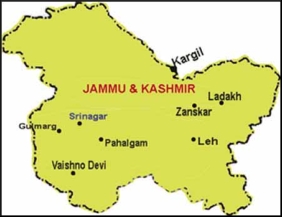|
|
|

|
Service sector drives J&K economy: CARE ratings report
|
|

|
|
| Top Stories |
 |
|
|
|
SME Times News Bureau | 10 Sep, 2019
The service sector drives the economy of the erstwhile state of Jammu
and Kashmir, contributing 56 per cent to the economic activity of the
region, a report by CARE ratings said.
The report, prepared in
view of the bifuraction of the state into Union Territories of Jammu and
Kashmir and Ladakh last month by the Narendra Modi government, said:
"The recent constitutional changes in Jammu and Kashmir have led to
discussions about the economic and business opportunities the region
holds. While opportunities have always existed in the state, the
possibility of easier access for investment does present several
scenarios."
It highlighted that the "service sector" drives the
region's economy, contributing 56 per cent. "The industrial and
agriculture sector accounts for 28 per cent and 16 per cent respectively
of the economic output," it said.
The report also noted that
manufacturing has a low share in economic output of the region,
contributing around 10 per cent to the local economy, less than the
national average of 18 per cent.
It also pointed out that the
region has had an indifferent track record in terms of industrial
entrepreneur memorandum (IEMs) intentions being filed and implemented.
Over
the years, the IEMs filed have declined considerably from 23 in
financial year 2010 to 5 - in sectors such as chemicals, hotel and
textiles - in financial year 2019 and the investment implemented has
been "nil" in most years.
"The foreign investments into the
region by way of FDI have been negligible. It was less than $1 million
during Financial Year 19 ($0.06 million) when the inflows into the
country was around $ 44.3 billion," the report said.
The report
also pointed out that the factories in Jammu and Kashmir accounts for
only 0.4 per cent of the total factories in the country, as per the
Annual Survey of Industries.
"The numbers of factories have grown
at a CAGR of 4 per cent during Financial Year 2008-17. As of 2016-17,
Jammu and Kashmir had a total of 1,016 factories of which only 938 were
operational," it said.
It also said that these factories were
mainly involved in the manufacture of food products (15 per cent),
chemical (12 per cent), rubber and plastics products (12 per cent),
basic metals (10 per cent) and electrical equipment (8 per cent).
Industrial activity is mainly concentrated in small scale units, it added.
According
to the report, the region was mainly dependent on the Central
government for its revenues with nearly 74 per cent of the state's
revenues coming from the centre by way of grants and share in central
taxes. "As such, the region has low self-reliance," it said.
However,
the banking infrastructure and coverage in the region is better than
the national average. As of 2017-18, there were 142 banking offices per
million of population in Jammu and Kashmir, which is more than the
national average of 109.3 bank offices per million population.
In
financial year 2018, the credit to deposit ratio was at 43.6 per cent
much lower than the ratio of 76.7 per cent at national level, the report
said.
About apple cultivation in Jammu and Kashmir, the report
said that it was the major contributor. In 2017-18, apple production in
India stood at 23.2 lakh tonnes, out of which Jammu and Kashmir
contributed the majority share of 77.7 per cent, followed by Himachal
Pradesh and Uttarakhand with a share of 19.2 per cent and 2.5 per cent,
respectively.
It said that apple production has a special
prominence in J&K with the industry acting as a source of livelihood
for many people in the region on account of its backward and forward
linkages.
The report said as per Ministry of Food Processing
Industries' annual report 2018-19, the number of registered and
unincorporated food processing units in J&K stand at 176 and 28,089,
respectively.
Apart from these units, a mega food park project
is under implementation, four cold chain projects stand completed and
two cold chain projects are under implementation and two abattoirs are
under setting up mode as on March 31, 2019. In addition to this, a food
testing laboratory and 12 food processing units were completed till
March 31, 2019.
The opening up of J&K region for investments
in food processing industry is expected to "augur well" for FMCG
products like apple jam, apple juice, apple cider etc, it said.
The report also highlighted that the hospitality and hotel sector, retail and education sector can grow in the state.
|
|
|
| |
|
|
|
|
|
|
|
|
|
|
|
|
|
|
| |
| Customs Exchange Rates |
| Currency |
Import |
Export |
US Dollar
|
₹91.25
|
₹89.55 |
UK Pound
|
₹122.85
|
₹118.85 |
Euro
|
₹107.95
|
₹104.3 |
| Japanese
Yen |
₹59 |
₹57.1 |
| As on 29 Dec, 2025 |
|
|
| Daily Poll |
 |
 |
| What is your biggest hurdle to scaling right now? |
|
|
|
|
|
| Commented Stories |
 |
|
|
|
|
|
| |
|